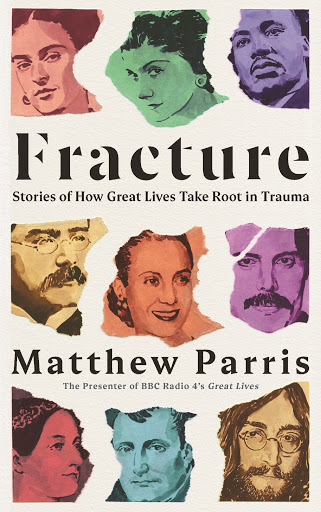 Fracture: How Great Lives Take Root In Trauma
Fracture: How Great Lives Take Root In Trauma
by Matthew Parris
Profile Books
For over a decade, Matthew Parris has presented a program called Great Lives on BBC Radio. The series has covered the stories of over 400 people from all walks of life who are no longer alive and he noticed that a high proportion of these exceptional people had childhood traumas.
While fairy stories are full of characters that overcome trauma, he saw that trauma which should have wrecked these people’s lives actually made them into extraordinary individuals. Acknowledging that some people achieve greatness without suffering trauma, Parris wanted to explore why these damaged children didn’t become damaged adults but outstanding people.
I always thought Pink came up with the idea, but it was the nineteenth century German philosopher Friederich Nietzsche came up with the maxim “whatever doesn’t kill you makes you strong”. And studies have shown that many geniuses have experienced “unusual and unexpected events in their childhood and adolescence, even highly traumatic events that have set them apart”.
Parris divides his biographical anecdotes into five categories of childhood trauma – physical and mental affliction; isolation and dislocation; chaos and family dysfunction; cruelty in the form of oppression or prejudice and shock. His book is a fascinating look at the turning points in the lives of many famous people.
John Lennon imagined a better world than the one he experienced as a 5 year old and Freddie Mercury had his life shattered at the age of 8 and never got over feeling all alone in the world. Rapper Tupac Shakur captured the imagination of a generation after an isolated childhood and Edith Piaf’s songs echoed with the tragedies of her personal life.
Napoleon Bonaparte was bullied by students and teachers during his 6 years at military school for being a Corsican outsider and Lenin wanted revenge on a political system that executed his brother. Genghis Khan cried easily and was afraid of dogs but something spurred him on to kill his half brother at the age of 13 and become the family hero.
Carl Jung struggled with his mother’s mental illness as did Charlie Chapman who ended up in workhouses when his mother went into an asylum. Coco Channel went from being destitute as a child to revolutionizing women’s fashion. Being poor and gay and having a Muslim heritage spurred Russian Rudolph Nureyev to take dancing to unexplored levels of brilliance.
While childhood traumas are evident in Frida Kahlo’s art work, we’ll never know if the tragedy in Marie Curie’s life spurred her onto greatness. The fracture doesn’t actually have to appear all that large to outsiders to cause trauma – as in a young Martin Luther King citing that being forced to stand on a nine hour bus trip so the white kids could sit for the journey was his inspiration to change the world.
Parris proposes an interesting thesis and it is engrossing reading how people in history have crawled and run for the wreckage of their childhoods. I loved the young Orson Well’s realisation that grown-ups weren’t in charge of his life. “Nobody was in charge, and that if you knew what to do you had to take control of it for yourself”.
Lezly Herbert

Love OUTinPerth Campaign
Help support the publication of OUTinPerth by contributing to our
GoFundMe campaign.





